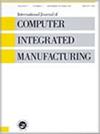增材制造中的机器学习特刊
IF 4
3区 工程技术
Q2 COMPUTER SCIENCE, INTERDISCIPLINARY APPLICATIONS
International Journal of Computer Integrated Manufacturing
Pub Date : 2023-07-11
DOI:10.1080/0951192X.2023.2235679
引用次数: 0
摘要
经过30年的不断发展,增材制造已经成功地获得了主流的认可,成为一种流行的制造工艺。通过基于3D模型逐层创建产品,增材制造允许生产复杂零件,在设计优化方面具有更大的自由度,超越了传统制造技术(Gibson et al. 2021)。与此同时,机器学习已经成为一项热门技术,在医学诊断、图像处理、预测、分类、学习关联和回归等领域有许多应用(Kotsiantis, Zaharakis, and Pintelas 2006)。这引起了人们对机器学习在制造业中的应用的越来越多的关注,特别是在增材制造领域(Jiang et al. 2020;Qin et al. 2022)。机器学习在增材制造中的快速发展为我们带来了这个特别的问题,我们希望将具有不同研究背景的研究人员聚集在一个共同的论坛上,通过机器学习的帮助来加速增材制造技术的发展。我们热衷于为这一前沿研究课题做出贡献,并推动增材制造技术的进一步发展。本次特刊共收稿9篇,作者分别来自德国、印度、丹麦、美国、澳大利亚、加拿大、新加坡和中国。论文“增材制造技术中的机器学习调查”(Jiang 2023)对增材制造中的机器学习进行了最新的调查,并为机器学习在增材制造中的未来应用提供了一些指导方针。下一篇论文“基于深度学习的图像增强,用于基于光学摄像机的激光粉床融合过程监控系统”(Zhang et al. 2022)介绍了一种基于U-Net的超分辨率(SR)算法,该算法可以有效增强激光粉床融合(LPBF)过程中光学摄像机监控图像的细节。在实验室建立了一个测试装置,生成高分辨率图像用于训练。为了获得准确的原始图像以进行验证,通过缩小和模糊高分辨率图像来创建低分辨率图像。使用峰值信噪比(PSNR)和细节的合理性作为度量来评估SR算法的有效性。结果清楚地表明,该算法能够在LPBF过程中从低分辨率图像中重建复杂的特征。论文“利用人工神经网络和遗传算法预测用熔融沉积建模制造的丙烯腈-丁二烯-苯乙烯零件的力学性能”(Mohd et al. 2022)使用多参数回归模型预测用熔融沉积建模制造的丙烯腈-丁二烯零件的力学性能。该模型建立了正确选择工艺参数与提高熔融沉积建模性能之间的直接关系。该模型能够提供分配输出值的最优解。论文“缸内光聚合错误检测的在线监测”(Frumosu et al. 2023)提出了一种自下而上光聚合增材制造系统的在线监测系统。传感器产生的数据用于检测制造零件与构建平台的分离误差,这是机器操作员无法实际观察到的。如果未被发现,这种分离可能会导致材料浪费和停机,而不会停止正在进行的构建工作。在线监测过程分两个不同的阶段进行:离线训练阶段,然后是在线监测阶段。在离线阶段,训练一个预测模型,与在线监测的控制图一起使用。监测控制图是特别有益的,因为它允许检测和记录脱离预测。下一篇论文“在智能制造中使用监督数据进行异常检测的学习”(Meiling et al. 2023)提出了一种模型选择架构。9,1255 - 1257 https://doi.org/10.1080/0951192X.2023.2235679本文章由计算机程序翻译,如有差异,请以英文原文为准。
Special issue on machine learning in additive manufacturing
After 30 years of continuous development, additive manufacturing has successfully achieved mainstream acceptance as a popular manufacturing process. By creating products based on a 3D model, layer-bylayer, additive manufacturing allows for the production of complex parts with greater freedom in design optimization, surpassing traditional manufacturing techniques (Gibson et al. 2021). Meanwhile, machine learning has emerged as a hot technology with numerous applications in medical diagnosis, image processing, prediction, classification, learning association, and regression (Kotsiantis, Zaharakis, and Pintelas 2006). This has drawn increasing attention towards the use of machine learning in the manufacturing industry, particularly in the field of additive manufacturing (Jiang et al. 2020; Qin et al. 2022). The rapid progress of machine learning in additive manufacturing has brought us to this special issue, where we hope to bring together researchers with diverse research backgrounds in a common forum to accelerate the development of additive manufacturing technology through the aid of machine learning. We are enthusiastic about contributing to this cutting-edge research topic and driving further advancements in AM technology. In this special issue, there are nine papers accepted in the end with authors from Germany, India, Denmark, United States, Australia, Canada, Singapore, and China. The paper ‘A survey of machine learning in additive manufacturing technologies’ (Jiang 2023) gives a stateof-the-art survey on machine learning in additive manufacturing and provides some guidelines for future applications of machine learning in additive manufacturing. The next paper ‘Towards deep-learning-based image enhancement for optical camera-based monitoring system of laser powder bed fusion process’ (Zhang et al. 2022) introduces a super-resolution (SR) algorithm based on U-Net that can effectively enhance the details of optical camera monitoring images in the laser powder bed fusion (LPBF) process. A test setup was constructed in the laboratory to generate highresolution images for training. To obtain accurate original images for validation purposes, lowresolution images were created by downscaling and blurring high-resolution images. The effectiveness of the SR algorithm was evaluated using the peak signalto-noise ratio (PSNR) and plausibility of details as metrics. The results clearly demonstrate that this SR algorithm is capable of reconstructing intricate features from low-resolution images in the LPBF process. The paper ‘Prediction of mechanical properties for acrylonitrile-butadiene-styrene parts manufactured by fused deposition modelling using artificial neural network and genetic algorithm’ (Mohd et al. 2022) uses a multi-parameter regression model to predict the mechanical properties of acrylonitrile-butadienestyrene parts manufactured by fused deposition modelling. The model establishes a direct relation between choosing process parameters correctly and enhancing performance in fused deposition modelling. The model can provide optimal solutions for getting allotted output values. The paper ‘Online monitoring for error detection in vat photopolymerization’ (Frumosu et al. 2023) proposes an online monitor system for bottom-up photopolymerization additive manufacturing systems. The data generated by the sensor is utilized to detect the detachment error of manufactured parts from the build platform, which cannot be physically observed by machine operators. If left undetected, this detachment can result in material waste and downtime, without stopping the ongoing build job. The online monitoring procedure is performed in two distinct phases: an offline training phase, followed by an online monitoring phase. During the offline phase, a prediction model is trained to be used in conjunction with a control chart for online monitoring. The monitoring control chart is particularly beneficial as it allows for the detection and recording of detachment predictions exclusively. The next paper ‘Learning with supervised data for anomaly detection in smart manufacturing’ (Meiling et al. 2023) proposes a model selection architecture INTERNATIONAL JOURNAL OF COMPUTER INTEGRATED MANUFACTURING 2023, VOL. 36, NO. 9, 1255–1257 https://doi.org/10.1080/0951192X.2023.2235679
求助全文
通过发布文献求助,成功后即可免费获取论文全文。
去求助
来源期刊
CiteScore
9.00
自引率
9.80%
发文量
73
审稿时长
10 months
期刊介绍:
International Journal of Computer Integrated Manufacturing (IJCIM) reports new research in theory and applications of computer integrated manufacturing. The scope spans mechanical and manufacturing engineering, software and computer engineering as well as automation and control engineering with a particular focus on today’s data driven manufacturing. Terms such as industry 4.0, intelligent manufacturing, digital manufacturing and cyber-physical manufacturing systems are now used to identify the area of knowledge that IJCIM has supported and shaped in its history of more than 30 years.
IJCIM continues to grow and has become a key forum for academics and industrial researchers to exchange information and ideas. In response to this interest, IJCIM is now published monthly, enabling the editors to target topical special issues; topics as diverse as digital twins, transdisciplinary engineering, cloud manufacturing, deep learning for manufacturing, service-oriented architectures, dematerialized manufacturing systems, wireless manufacturing and digital enterprise technologies to name a few.

 求助内容:
求助内容: 应助结果提醒方式:
应助结果提醒方式:


